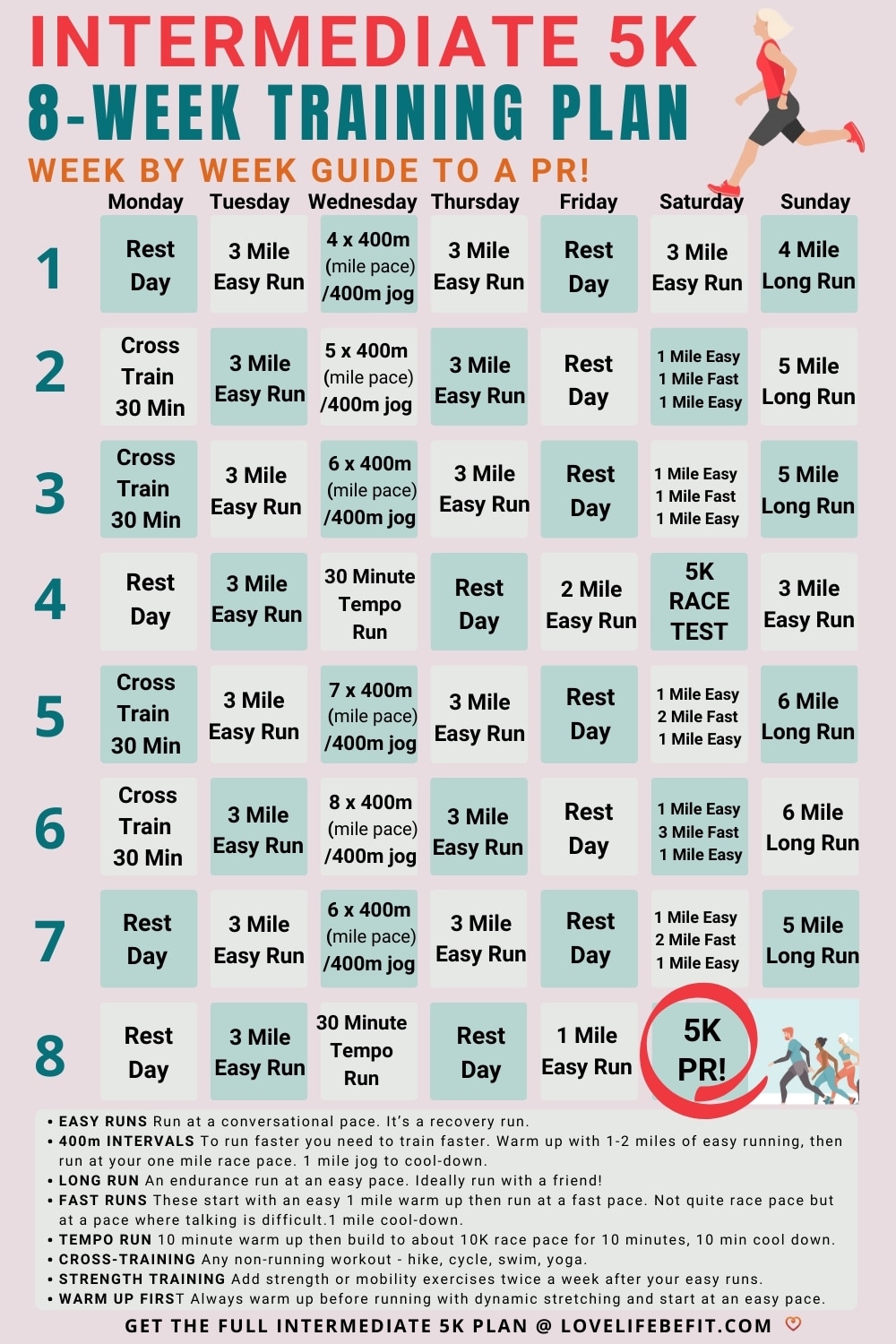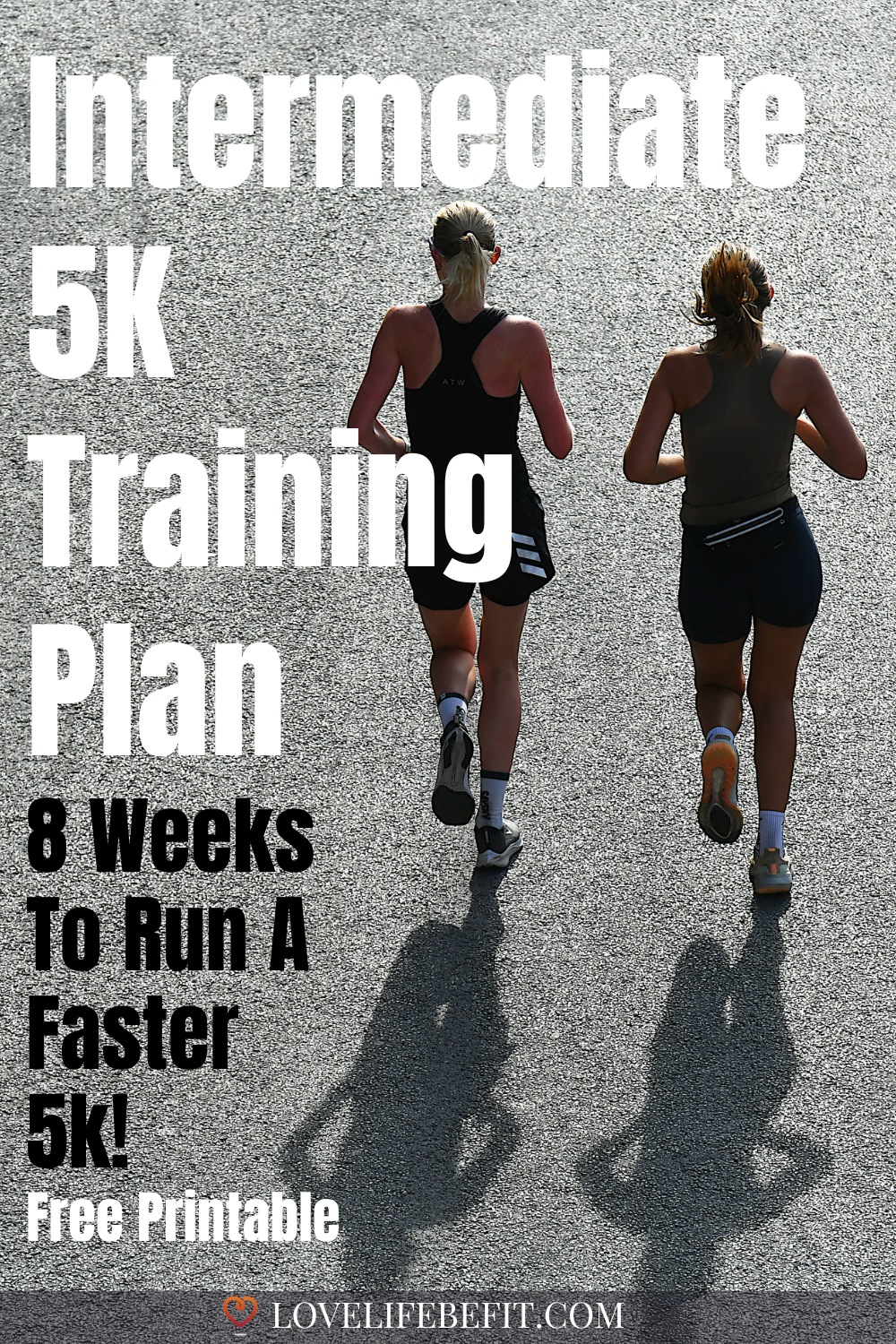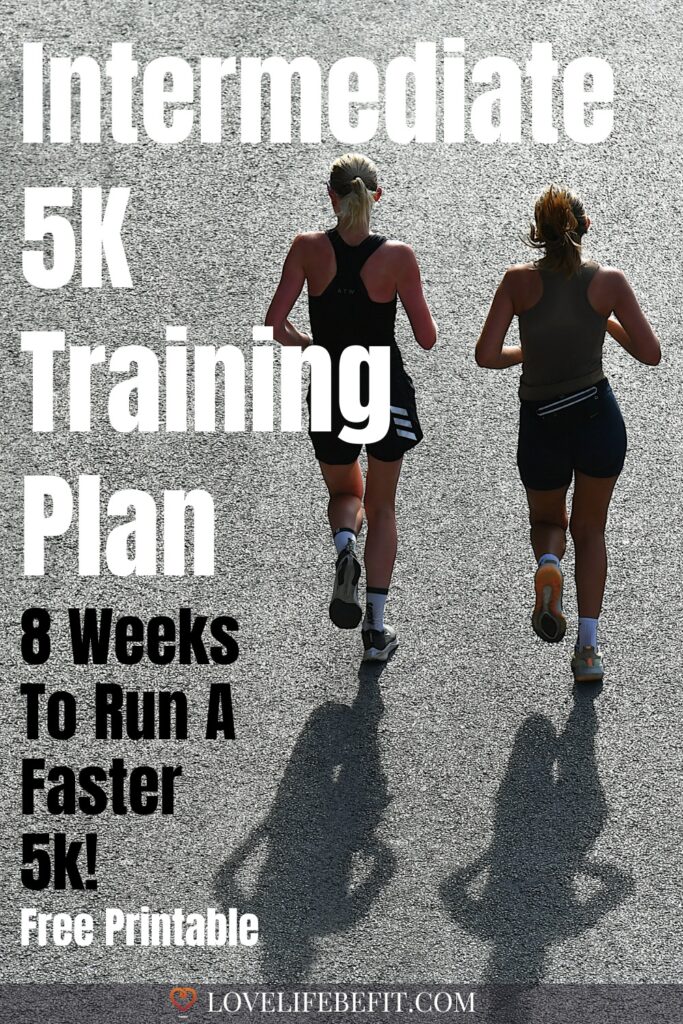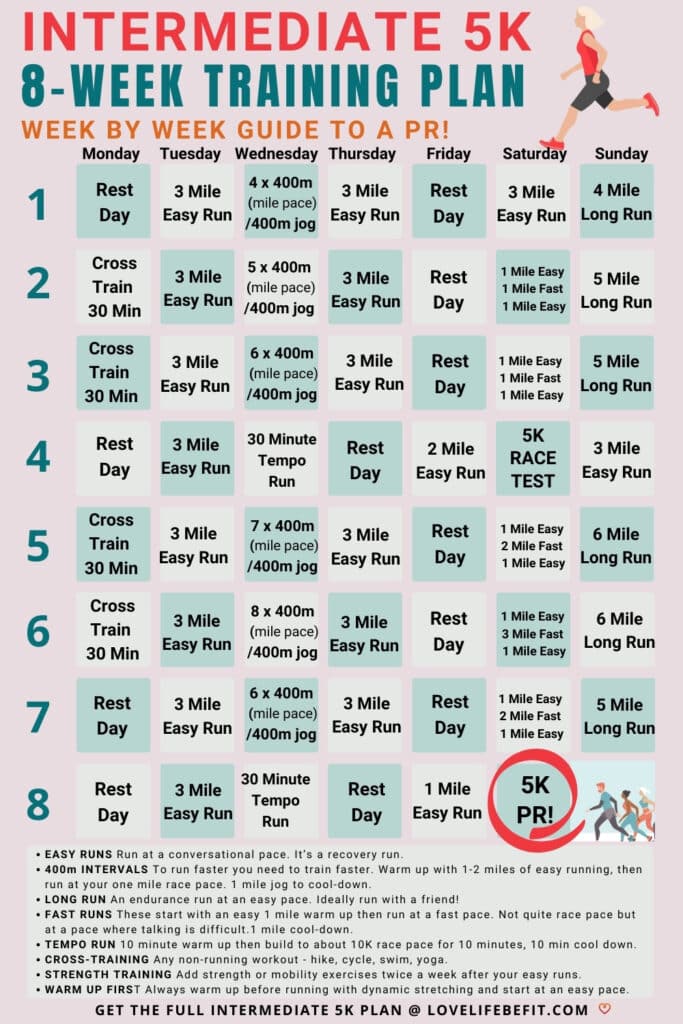5K Training Plan Intermediate (Week By Week Printable Plan)
Ready to run faster? This 5K Training Plan Intermediate is for runners who want to improve their 5K time. You’ve mastered the 5K distance and the next step is chasing a personal record (PR).
Intermediate runners often put their energy into running longer distances, stepping up to a half marathon, and even ultra distances. But racing shorter distances can often be better for you. There’s less repetitive stress on the body and improving your speed helps with all your running, not just 5K races.
Ace your next race by working on your speed and endurance!

Our 5K Training Plan Intermediate Runners
This training plan by a UESCA Certified Running Coach aims to help you run at a faster pace and hit your PR running goals!

What Is A Good 5K Time?
A good 5K time will vary widely based on your running experience, age, and sex.
For men, the average time to race 5K across all ages is 22:31.
For women, the average time to race 5K across all ages is 26:07.
Think these times sound too fast? Note these are average times and include times by elite runners.
The 5K average times for intermediate runners who have been running regularly for two years are summarized in the following table:
| Age Group | 5K Average Time Intermediate Men | 5K Average Time Intermediate Women |
| 20-29 | 22:31 | 26:07 |
| 30-39 | 22:43 | 26:12 |
| 40-49 | 24:11 | 27:18 |
| 50-59 | 26:08 | 30:04 |
| 60-69 | 28:27 | 33:51 |
| 70-79 | 31:43 | 38:44 |
| 80-89 | 39:06 | 46:10 |

How To Go From A 30-Minute 5K to a 25-Minute 5K
A sub-25 minute 5K is the holy grail for many runners. It’s a feasible target for most intermediate-level men, but women must be advanced runners to run under 25 minutes for 5K.
To run a faster 5K you need to improve both your endurance and running speed. There are 3 ways to do this:
- Run more miles.
- Train to run faster.
- Do both.
Doing both is the best approach if you’ve been running regularly for over a year. Speed training carries a high injury risk for beginner runners. Instead, it’s best to build up your leg strength with regular running.
It’s a big jump going from a sub-30 minute 5K to a 25-minute 5K. For some people, such an improvement could take years and others will manage it in just 8 weeks!
To run a 25-minute 5K you need to hit a race pace of:
5:00 minutes per kilometer, 8:03 minutes per mile.
Aim for slightly faster than this pace to run a sub-25 minute 5K.
Try and set a PR that’s feasible for you. Base it on your running experience, past performances, age, and sex.
How Many Weeks Should I Train For A 5K?
If you’re a beginner training to run your first 5K race, it can take from 4 to 12 weeks to train for a 5K. Take a look at our Couch to 5K and beginner 5K training plans.
For an intermediate runner aiming for a PR, 8 weeks is an ideal length of time to make a substantial improvement to your 5K race time.
Our 8-week intermediate 5K training plan has enough time to introduce interval training and includes a test race at the end of week 4.
Who Is This Plan For?
Ideally, this plan is for someone who’s been running regularly for at least a year and wants to improve their 5K time as their next fitness goal.
You should be:
- Running 15 to 20 miles a week.
- Have built up enough leg strength from regular running to withstand the impact of speed training.
- Completed several 5K races or timed 5K runs and be ready to improve your times.
If you’ve been running for less than a year, it’s better to focus on running regularly. You’ll naturally improve your running times the more you run.
Intermediate 5K Plan Week By Week Sessions
This training plan includes the following weekly sessions:

- 2 easy runs
- 1 interval session
- 1 long run
- 1 fast run
- 1 rest day
- 1 cross-training day.
There are a few weekly variations with a test race at the end of week 4 and extra rest days before the big day when you’ll set your 5K PR!
Easy Runs
Most of the time spent running will be at an easy pace. This helps to build your running efficiency and allows you to recover from speed sessions.
An easy run is at a comfortable pace. You’ll be able to hold a conversation without getting out of breath. It has a Rating of Perceived Exertion (RPE) of 3. It’s easy!
Interval Training
This plan assumes you’re new to high-intensity interval training. Starting with just 4 x 400m intervals, (known as 400m repeats), the number of intervals gradually increases as you progress through the plan.
To improve speed, you need to practice running faster. 400m repeats work on your speed endurance and will boost your top-end speed. Better speed endurance means you can run faster for longer.
400m repeats are used in training for many different race distances, even training for ultra marathons where you may run as many as 20 x 400m repeats.
For 5K training, the aim is to keep the number of repetitions lower, 6-8 is ideal, but to train at 90 percent of maximum effort.
Warm up properly with dynamic stretching and 1 to 2 miles of easy running. Run the 400m intervals at mile pace.
This will be faster than your 5K race pace and at an RPE of 9 – very hard running. Maximum focus, labored breathing, and talking almost impossible. Jog or walk 400m to recover.
400m repeats are ideal for running on a track but you can also complete this session on a treadmill or measuring the distance on a quiet road and using a stopwatch.
Never try intervals without a proper warm-up. This type of training carries a high injury risk and isn’t suitable for beginners.
Long Runs
A weekly long run is an important part of any training plan. The Intermediate 5K training plan starts the long run at 4 miles and builds to 6 miles over the plan.
The run should be enjoyable at a comfortable conversational pace. You should be able to talk and run. Stop and drink or take a walk break if you need to.
Tempo Run
In week 4 and 8, interval sessions are replaced with a tempo run. Start these tempo runs with 10 minutes of easy run, build up to a more challenging pace for 10 minutes – 10K pace RPE 6 where it’s harder to talk – then ease off to an easy pace for the last 10 minutes.
Fast Running
We have included some sessions with “fast running”. Base this fast running on how you feel on the day. It should be faster than your normal training pace, about RPE 5 to 6.
Expect to get a little out of breath and you may not be talking to your training partner except in snatched sentences.
Cross Training
The training schedule allows for some cross-training. This post, cross-training for runners explains the benefits.
Cross-training helps you to train smarter. Any activity such as swimming, cycling, or walking is beneficial. Stick to an activity you’re already used to instead of trying something new.
Alternatively, take an extra rest day.
Rest Days
These are essential for recovery – don’t skip them. To run faster you need to train hard and you need to be fully rested to get the most out of your speed sessions.
Strength Training
Adding some strength training to your weekly running workouts can help improve your body’s ability to run faster. We suggest these bodyweight exercises for runners.
Adding a short session after the easy run on a Thursday is ideal. Don’t try them before interval training!

5K Training Tips
#1 Train Hard But Not Too Hard
It’s best not to push too hard on your first 400m repeats. Take it a little easier than 90% effort and see how your body recovers.
It’s not just your cardio that you’re working hard. Your body needs to adjust to the faster intensity.
#2 Train With A Club
Unfortunately, we can’t all afford a personal trainer but training with a club can be the next best thing. A good running club will have regular speed training sessions. A lot of runners benefit from doing these faster sessions with other runners.
#3 Hill Workout
It’s a good idea to make sure some of your running is on hills and not just on the flat. This will improve your strength and endurance.
Add a hilly route once a week as an easy run or incorporate some hills on your long runs.
#4 Target Race Pace
Your race pace needs to be challenging but realistic. Aim to run the test race in week 4 at your target pace.
It will provide feedback on progress and you can adjust your training accordingly.
Advice From Love Life Be Fit
Running a faster 5K is about getting out of your comfort zone. Most of us are reluctant to train faster opting to run longer distances than go for speed.
Take on the challenge of this running plan and you could be surprised by the results. Often runners are held back by limiting beliefs more than ability. It just takes the right type of training to set a new 5K PR!
Running 101 Training Guides & Walking Schedules
5K Training Plans
- Couch To 5K Beginner Training Plan
- 12 Week 5K Training Plan
- 10 Week 5K Training Plan
- 8 Week 5K Training Plan
- 6 Week 5K Training Plan
- 4 Week 5K Training Plan
- 5K Training Plan Intermediate






